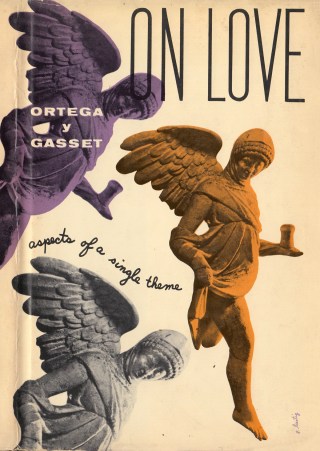“Love is an impulse which springs from the most profound depths of our beings, and upon reaching the visible surface of life carries with it an alluvium of shells and seaweed from the inner abyss.”
“Attention is the rarest and purest form of generosity,” the great French philosopher Simone Weil wrote shortly before her untimely death. An epoch after her, Mary Oliver eulogized the love of her life with the observation that “attention without feeling… is only a report.” Looking back on centuries of love poems by people of genius who dared to love beyond the cultural narrows of their time, the poet J.D. McClatchy observed that “love is the quality of attention we pay to things.”
Because our attention shapes our entire experience of the world — this, after all, is the foundation of all Eastern traditions of mindfulness, which train the attention in order to anneal our quality of presence — the objects of our attention end up, in a subtle but profound way, shaping who we are.
Because there is hardly a condition of consciousness that focuses the attention more sharply and totally upon its object than love, what and whom we love is the ultimate revelation of what and who we are.
That is what the great Spanish philosopher José Ortega y Gasset (May 9, 1883–October 18, 1955) explores in a series of essays originally written for the Madrid newspaper El Sol and posthumously published in English as On Love: Aspects of a Single Theme (public library) — a singular culmination of Ortega’s philosophic investigation of Western culture’s blind spots, biases, and touching self-delusions about love, that is, about who and what we are.
Illustration from the vintage Danish handbook An ABZ of Love
Defining love as “that sense of spiritual perception with which one seems to touch someone else’s soul, to feel its contours, the harshness or gentleness of its character,” Ortega notes that love reveals “the most intimate and mysterious preferences which form our individual character.” He writes:
There are situations, moments in life, in which, unawares, the human being confesses great portions of his ultimate personality, of his true nature. One of these situations is love. In their choice* of lovers [human beings] reveal their essential nature. The type of human being which we prefer reveals the contours of our heart. Love is an impulse which springs from the most profound depths of our beings, and upon reaching the visible surface of life carries with it an alluvium of shells and seaweed from the inner abyss. A skilled naturalist, by filing these materials, can reconstruct the oceanic depths from which they have been uprooted.
Defining attention as “the function charged with giving the mind its structure and cohesion,” Ortega places it at the center of the experience of love:
“Falling in love” is a phenomenon of attention.
[…]
Our spiritual and mental life is merely that which takes place in the zone of maximum illumination. The rest — the zone of conscious inattention and, beyond that, the subconscious — is only potential life, a preparation, an arsenal or reserve. The attentive consciousness can be regarded as the very space of our personalities. We can just as well say that that thing dislodges a certain space in our personalities.
Art by Dorothy Lathrop, 1922. (Available as a print.)
Half a century after William James — one of Ortega’s greatest influences and philosophical progenitors — laid the groundwork of modern psychology with his statement “My experience is what I agree to attend to,” Ortega adds:
Nothing characterizes us as much as our field of attention… This formula might be accepted: tell me where your attention lies and I will tell you who you are.
[…]
“Falling in love,” initially, is no more than this: attention abnormally fastened upon another person. If the latter knows how to utilize his privileged situation and ingeniously nourishes that attention, the rest follows with irremissible mechanism.
Art by Margaret C. Cook from a rare 1913 edition of Walt Whitman’s Leaves of Grass. Available as a print.
Paradoxically, the cultural narrative handed down to us by the Romantics postulates that love broadens and consecrates our awareness of life: Suddenly, everything is illuminated; suddenly, everything sings. Anyone who has ridden the intoxicating elation of early love has felt this, and yet Ortega intimates that this is an illusion of consciousness, masking the actual phenomenon at work, which is rather the opposite — everything is tinted with aspects of the beloved, blurring and tuning out the details that give the world its actuality. Ortega writes:
The person in love has the impression that the life of his consciousness is very rich. His reduced world is more concentrated. All of his psychic forces converge to act upon one single point, and this gives a false aspect of superlative intensity to his existence.
At the same time, that exclusiveness of attention endows the favored object with portentous qualities… By overwhelming an object with attention and concentrating on it, the consciousness endows it with an incomparable force of reality. It exists for us at every moment; it is ever present, there alongside us, more real than anything else. The remainder of the world must be sought out, by laboriously deflecting our attention from the beloved… The world does not exist for the lover. His beloved has dislodged and replaced it… Without a paralysis of consciousness and a reduction of our habitual world, we could never fall in love.
Art from the 19th-century French physics textbook Les phénomènes de la physique. (Available as a print.)
Long before cognitive scientists came to study what “an intentional, unapologetic discriminator” attention is as it frames our experience of reality by deliberate exclusion, Ortega writes:
Attention is the supreme instrument of personality; it is the apparatus which regulates our mental lives. When paralyzed, it does not leave us any freedom of movement. In order to save ourselves, we would have to reopen the field of our consciousness, and to achieve that it would be necessary to introduce other objects into its focus to rupture the beloved’s exclusiveness. If in the paroxysm of falling in love we could suddenly see the beloved in the normal perspective of our attention, her magic power would be destroyed. In order, however, to gain this perspective we would have to focus our attention upon other things, that is, we would have to emerge from our own consciousness, which is totally absorbed by the object that we love.
Nothing illustrates this contracting of the lens more clearly than the discomposing experience of emerging from the somnambulant state of in-loveness — an experience familiar to anyone who has ever surfaced from an infatuation or has deepened an infatuation into a clam and steady love. Ortega writes:
When we emerge from a period of falling in love we feel an impression similar to awakening and emerging form a narrow passage crammed with dreams. Then we realize that normal perspective is broader and airier, and we become aware of all the hermeticism and rarefaction from which our impassioned minds suffered. For a time we experience the moments of vacillation, weakness, and melancholy of convalescence.
One of Antoine de Saint-Exupéry’s original watercolors for The Little Prince.
But despite its potential pitfalls, love remains at once the most interior and the most influential experience of our personhood. In a sentiment evocative of that exquisite line from The Little Prince — “What is essential is invisible to the eye.” — Ortega considers how love, so invisible yet so essential a feature of our humanity, polishes the lens of our entire worldview:
The things which are important lie behind the things that are apparent.
[…]
Probably, there is only one other theme more inward than love: that which may be called “metaphysical sentiment,” or the essential, ultimate, and basic impression which we have of the universe. This acts as a foundation and support for our other activities, whatever they may be. No one lives without it, although its degree of clarity varies from person to person. It encompasses our primary, decisive attitude toward all of reality, the pleasure which the world and life hold for us. Our other feelings, thoughts, and desires are activated by this primary attitude and are sustained and colored by it. Of necessity, the complexion of our love affairs is one of the most telling symptoms of this primogenital sensation. By observing our neighbor in love we are able to deduce his vision or goal in life. And this is the most interesting thing to ascertain: not anecdotes about his existence, but the card upon which he stakes his life.
Art by Jean-Pierre Weill from The Well of Being
And yet our culture has a peculiar willful blindness to how love shapes life and the particular expression of aliveness that is our creative work — a peculiar denial of the elemental fact that because we love with everything we are, our loves imprint everything we make. (I wrote Figuring in large part as an antidote to this dangerous delusion, exploring how the loves at the center of great lives shaped the way in which those persons of genius in turn shaped our understanding of the world with their scientific and artistic work.) Ortega shares in this distaste for the cultural diminishment of love as a driving force of creative work. Observing that many persons extraordinary creative power have tended to take their loves “more seriously than their work” — the very work for which they are celebrated as geniuses, and a choice for which they have suffered derision by their contemporaries and by posterity — he admonishes against this common cultural judgment:
It is curious that only those incapable of producing great work believe that the contrary is the proper conduct: to take science, art, or politics seriously and disdain love affairs as mere frivolities.
Crochet mural by street artist NaomiRAG, Greenpoint, Brooklyn. Photograph by Maria Popova. (Available as a print.)
A century and a half after astronomer Maria Mitchell — a key figure in Figuring — observed that “whatever our degree of friends may be, we come more under their influence than we are aware,” Ortega laments:
We do not take into sufficient consideration the enormous influence which our loves exercise upon our lives.
But while love reveals who we are, it also shapes who we are, sculpting our character and tinting our personality. The century of psychology developed since Ortega’s epoch has illuminated just how much “who we are and who we become depends, in part, on whom we love.” Ortega intuits this transformative power of love and, in consonance with Kurt Vonnegut’s theory that you can be in love up to three times in life, he writes:
A personality experiences in the course of its life two or three great transformations, which are like different stages of the same moral trajectory… Our innermost being seems, in each of these two or three phases, to rotate a few degrees upon its axis, to shift toward another quadrant of the universe and to orient itself toward new constellations.
Art by Dorothy Lathrop, 1922. (Available as a print.)
Complement these fragments from Ortega’s intensely insightful On Love with Adrienne Rich on how relationships refine our truths, James Baldwin on love and the illusion of choice, and Esther Perel on our greatest misconception about love, then revisit what remains my favorite meditation on the subject from centuries of literature and philosophy: Hannah Arendt on love and how to live with the fundamental fear of loss.
donating = loving
For 15 years, I have been spending hundreds of hours and thousands of dollars each month to keep Brain Pickings going. It has remained free and ad-free and alive thanks to patronage from readers. I have no staff, no interns, no assistant — a thoroughly one-woman labor of love that is also my life and my livelihood. If this labor makes your life more livable in any way, please consider aiding its sustenance with donation.
newsletter
Brain Pickings has a free weekly newsletter. It comes out on Sundays and offers the week’s most inspiring reading. Here’s what to expect. Like? Sign up.





